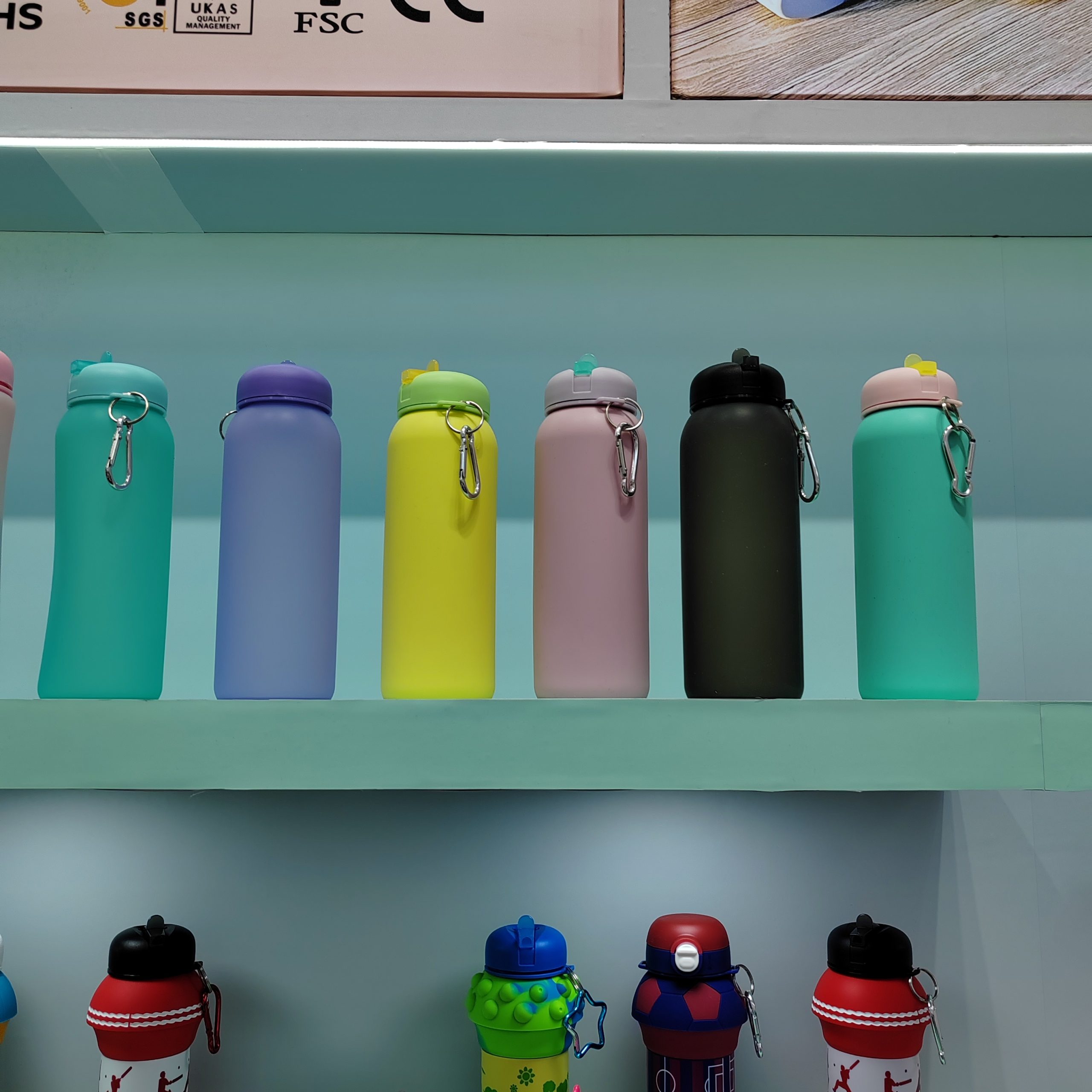Contenido
Introduction: Understanding the Basics of Silicone Product Manufacturing
Our goal is to familiarize you with the fundamental terminology that underpins the silicone industry. By enhancing your knowledge, we aim to empower you to make informed decisions when it comes to silicone products such as silicone water bottles, silicone lunch boxes, and silicone molds. As a leading silicone factory, we specialize in providing high-quality, custom silicone products tailored to the needs of wholesale clients.
![]()
![]()
Material Insight: Silicone vs. Silicon
Silicone, a synthetic polymer, is often confused with silicon, a naturally occurring element. Silicon is the 14th element on the periodic table and is the second most abundant element in the Earth’s crust. When combined with oxygen, it forms silicates, which are the basis for many minerals. On the other hand, silicone is made by polymerizing siloxanes, which are chains of alternating silicon and oxygen atoms, often modified with organic groups. This distinction is crucial in Silicone Product Manufacturing, as the properties of these materials differ significantly.
![]()
![]()
Polymerization and Crosslinking
In Silicone Product Manufacturing, the process of creating silicone involves two key steps: polymerization and crosslinking. During polymerization, siloxane monomers link together to form long, flexible polymer chains. Crosslinking then occurs, either through peroxide curing or platinum curing, which creates a three-dimensional network that gives silicone its unique elastic and durable properties. The choice between peroxide and platinum curing depends on the desired final properties and regulatory requirements, such as FDA or LFGB standards, which typically favor platinum-cured silicones due to their purity and lack of by-products.
Types of Silicone Used in Manufacturing
– LSR (Liquid Silicone Rubber)
Ideal for products requiring high precision and a smooth surface finish, such as our silicone water bottles. LSR can be processed at lower temperatures, allowing for faster cycle times and more intricate designs.


– HCR (High Consistency Rubber)
Suitable for applications where thicker walls and robust structures are needed, like our silicone lunch boxes. HCR is commonly used in compression and transfer molding processes.
– RTV (Room Temperature Vulcanizing)
Often used in DIY and small-scale projects, RTV cures at room temperature, making it convenient for prototyping and repairs.
– FSR (Fluorosilicone Rubber)
Offers enhanced resistance to fuels and solvents, making it suitable for specialized applications in harsh environments, though not typically used in our consumer products.
– Precipitated Silica
Acts as a reinforcing filler, improving the mechanical properties of silicone, and is often used in conjunction with LSR and HCR to enhance strength and durability.
– Fumed Silica
Used as a thickening agent, it enhances the viscosity of liquid silicone systems, aiding in the processing of LSR and ensuring uniform distribution within the mold.
Curing Methods and Regulatory Compliance
– Peroxide Curing
FDA-compliant products often use peroxide curing instead of platinum curing when considering cost-effectiveness. Peroxide curing involves the use of peroxides as initiators, which decompose to form free radicals and trigger cross-linking. It can meet the requirements of FDA testing, namely 21 CFR Part 177, which specifies the requirements for polymers in contact with food, including not exceeding the maximum allowable amount of chemical substances extracted in extraction testing.
– Platinum Curing (Addition Curing)
Uses a platinum-based catalyst, resulting in a cleaner, more consistent cure without the formation of by-products. This method is generally preferred for LFGB compliance, as it meets the stringent safety and quality standards required for food-grade and medical-grade applications.
FDA and LFGB Requirements
– FDA (Food and Drug Administration) Standards: Focus on the absence of harmful substances and the presence of safe additives. Platinum-cured silicones, due to their purity, are more likely to meet FDA standards, especially for items like silicone water bottles and lunch boxes that come into contact with food.
– LFGB (Lebensmittel-, Bedarfsgegenstände- und Futtermittelgesetzbuch) Standards: Similar to the FDA, LFGB requires that materials do not contain harmful substances and are safe for human health. Again, platinum-cured silicones are favored for their purity and lack of by-products, ensuring they pass the rigorous testing for food contact materials.
The Role of Vulcanization & Post-Curing
– Vulcanization Process and Its Importance
This process involves heating the silicone in the presence of a curing agent to form crosslinks between the polymer chains. It imparts strength, elasticity, and thermal stability to the silicone, essential for the durability and performance of the final product.
– Post-Curing: Secondary Heat Treatment
After initial vulcanization, post-curing is often performed to further improve the physical properties of the silicone. This secondary heat treatment helps to remove any remaining volatile compounds, enhance the crosslink density, and achieve the optimal mechanical and chemical properties required for specific applications.
Molding Methods in Silicone Product Manufacturing
– Injection Molding
Ideal for high-volume production of complex shapes. LSR is commonly used in this process due to its low viscosity and ability to fill intricate molds, making it perfect for our silicone water bottles.
– Compression Molding
Suitable for large, simple parts where precision is not critical. HCR is often used in compression molding, as seen in the production of our silicone lunch boxes.
– Transfer Molding
A versatile method for producing parts with inserts or complex geometries. Both LSR and HCR can be used, depending on the specific requirements of the product.
– Liquid Injection Molding (LIM)
Combines the advantages of both injection and compression molding, offering superior surface finish and dimensional accuracy. LSR is the primary material used in LIM, ensuring high-quality, precise parts.
– Extrusion
Best for continuous profiles like tubing and strips, enabling the production of consistent, uniform products. RTV and FSR can be extruded, but LSR is also used for more specialized extruded products.
Material Properties and Design Considerations
– Tensile Strength: Determines the maximum stress a material can withstand before breaking. For example, LSR used in our water bottles has a high tensile strength, ensuring durability.
– Tear Resistance: Indicates the material’s ability to resist tearing. HCR, used in our lunch boxes, offers excellent tear resistance.
– Compression Set: Measures the permanent deformation after being compressed. This is important for maintaining the shape and functionality of our products over time.
– Hardness (Shore A): Affects the feel and flexibility of the final product. Our productos de silicona are designed with specific hardness levels to ensure comfort and usability.
– Thermal Conductivity: Important for applications requiring heat dissipation. Our silicone products, particularly those used in kitchenware, are designed to handle a wide range of temperatures.
– Chemical Resistance: Ensures the product’s durability in various environments. FSR, while not used in our consumer products, is an example of a silicone type with exceptional chemical resistance.
Design Elements in Silicone Product Manufacturing
– Parting Lines: Critical for mold design, affecting the appearance and functionality of the final product. In our silicone water bottles and lunch boxes, parting lines are carefully designed to minimize visible seams and ensure a smooth, professional finish.
– Flash: Managing the excess material that may occur at parting lines to ensure a clean, professional finish. We employ advanced molding techniques to minimize flash, ensuring that our products meet the highest quality standards.
– Viscosity Control: Vital for ensuring the flow and fill of the mold, impacting the overall quality and consistency of the manufactured item. Precise control of viscosity is crucial, especially in LSR and HCR processes, to achieve the desired thickness and uniformity in our silicone products.
By delving into these aspects of Silicone Product Manufacturing, we hope to provide a comprehensive overview that highlights the expertise and capabilities of our silicone factory in delivering top-tier, custom silicone products to our valued wholesale partners.


